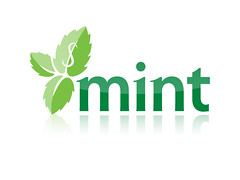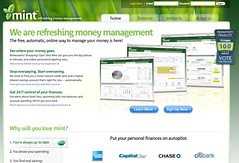Tracking Where Your Money Goes

Last week at work I was teased for being so financially tight that you can hear me squeak when I walk down the hall. This was a result of bringing a can of soda with me when we went out to eat because I refused to pay $2 for a cup of soda with my plate lunch. Yeah, ha ha, laugh now, but I saved myself $2 ($10/week, $40/month, $480/year)! After all, I am “Pahkee"/Chinese.
To a certain extent, I guess I do match that old stereotype, but it’s all for the good. I’m always watching what I spend. To boost my penny-pinching skills, I found a new website called Mint. It’s a fresh (hence its name), easy and free way to track where your money goes.
The setup is quick and simple. You create a username/password, add in your bank accounts and credit cards (by web logins) and Mint shows you instant graphs/charts of your spending. When I first login, I see an overview of what I spent on shopping, restaurants, gas, entertainment and groceries (based on my credit card information).
Clicking on the Transactions tab, you can see everything you charged on your credit cards, fully categorized, which feeds the Spending Trends pie chart. Some of my charges were not exactly accurate as far as type goes, but it was close enough.
SpendSpace allows you to compare your spending to others Mint users (anonymously), so you can see how you match up.

At the moment, more than 5,000 U.S. financial institutions participate with Mint, and each night it connects to these to update your user’s account information. Unfortunately one of my banks is not currently in there, but I’ve requested it to sign up. Not sure how long that will take, but anything you don’t see in there can easily be requested.
Mint goes beyond just reporting, by using a search algorithm to search through thousands of offers from hundreds of providers to find the best deals on credit cards, bank accounts, Internet plans and more. It will look at the percentage rate on your current accounts and recommends opening other accounts with higher rates. In my case, it recommended opening an account with Washington Mutual to earn 4 percent APY with my savings account. I didn’t follow that recommendation (yet), but I’m waiting to see what else it presents to me.
If you’re worried about security while you’re logging into Mint, to ease your mind: Its security and privacy have been validated by VeriSign, Trust-e and HackerSafe. It protects your information with bank-level security and 128 bit-encryption. You’ll always be notified of upcoming bills, low balances and any unusual activity in any of your accounts through this one interface. If you have a cell phone that can access the Internet, Mint is mobile, too.
In addition, on the mint.edu portion of Mint’s website there’s a selection of useful articles filled with good ideas on saving money. I find this especially important these days with inflation and the cost of gas going up every day. This site definitely makes personal budgeting easy and just adds to my “Pahkee-ness.”
After two years of development, Mint is currently in public beta status and absolutely free. It’s a much better alternative to Quicken Deluxe and other similar software. Start monitoring your finances and access Mint at www.mint.com.


0 Comments:
Post a Comment
<< Home